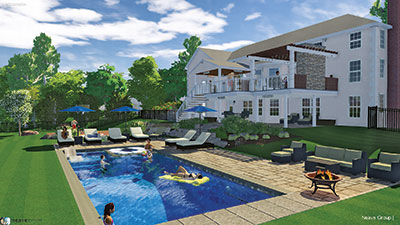
How an emerging technology helps one landscape company sell more jobs.
There’s no question that a 3D design rendering can close a deal. Without a picture, many clients struggle to visualize what you’re proposing. But even a picture has its limits, according to Neave Group Outdoor Solutions, which is using an emerging technology—virtual reality—to bring its landscape designs to life in a way that wows and sells.
“I have yet to demonstrate it to someone who was not amazed,” says Senior Pool Design Lee Kind, who’s also a technology guru and introduced virtual reality (VR) to the company. “Everyone who sees their project in virtual reality is blown away.”
Still, Kind says VR, which is the computer-generated simulation of a 3D environment that can be interacted with by a person using special equipment like a headset—is not without its kinks.
The biggest issue is clients sometimes get nauseated by the feeling of moving around in a virtual world. Kind says that he always gives the client a “warning” and points out that roughly one out of every four people tends to get a “seasick type of feeling” from the technology. It’s easily remedied by taking a break.
But Kind says even the clients who’ve felt sick are still impressed.

“It gives them a better understanding of what the project will really look like when it’s finished,” he says. “Renderings can’t give you the heightened sense of understanding that virtual reality will—because with virtual reality you’re in the drawing. You can actually walk around in the space.”
Implementing VR has meant investing in Oculus Rift goggles, which cost about $500, as well as a “gaming laptop,” which typically runs around $2,500.
The larger investment is in time.
“Whereas an average rendering might have taken me 10 to 20 hours outside of using virtual reality, a virtual reality design is going to be more like 20 to 30 hours of design time,” Kind says. “That’s because every detail has to be precise. On a rendering, the client wouldn’t notice one small thing out of place, but in a virtual world, they will. You can’t have a boulder floating in the sky, for instance.”

Because of the high level of detail required, Kind says it’s too time consuming for smaller projects. But it’s absolutely something he’ll do for a large project—and it pays off.
“I have a higher closing ratio when I use the virtual reality than when I do not,” Kind says. “That makes the time investment worth it for a larger project.”
Kind says implementing VR capabilities also has kept the company on the “cutting edge”—a place where he says it’s always been and makes an effort to stay.
“I started using 3D rendering software back in 2006 when it was still brand new at that point,” Kind says. “Now 3D has become commonplace—almost expected—and virtual reality is the new cutting-edge technology. If it follows the same pattern as 3D, it will become more commonplace down the road when something else takes its place—maybe holograms or another new technology. Our goal is always to keep up with what’s new.”
Photos: Neave Group Outdoor Solutions


